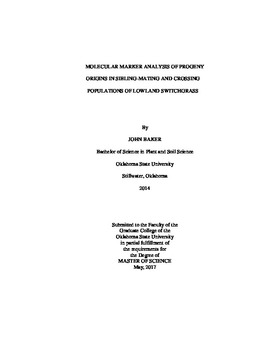| dc.contributor.advisor | Wu, Yanqi | |
| dc.contributor.author | Baker, John Houston | |
| dc.date.accessioned | 2018-03-13T18:14:54Z | |
| dc.date.available | 2018-03-13T18:14:54Z | |
| dc.date.issued | 2017-05-01 | |
| dc.identifier.uri | https://hdl.handle.net/11244/54480 | |
| dc.description.abstract | Abstract:Switchgrass (Panicum virgatum L.) is a C4 perennial grass which has been used for soil and water conservation and as forage for decades. In recent years it has been targeted for development as a bioenergy crop. However, breeding methods for developing economically viable hybrid cultivars are not available to improve switchgrass. Accordingly, the objective of this study was to assess genetic origins and seed yields of S1, S2, and S3 inbreds when grown in isolated sibling-mating, and crossing-plots of two conditionally self-compatible lowland switchgrass genotypes. Inbred progeny of two conditionally self-compatible switchgrass plants �NL94 LYE 16�x13� (NL94) and �SL93 7x15� (SL93) were established in 6 sibling-mating and 4 crossing plots at the Agronomy Research Station, Oklahoma State University in 2013. Seed yields for each plot were measured in 2014 and 2015. Seeds of 5 selected plants in each sibling-mating plot and of 5 plants of each genotype in the crossing plots were harvested separately for genotyping to determine parental origins. Significant effects on seed yield due to genotype, parental selection, and inbreeding depression were noted. Progeny origins were determined using 6 or 10 simple sequence repeat (SSR) markers. In sibling-mating plots, a high preference for sibling-mating over selfing was observed in both SL93 and NL94 S1 parents which set 68% and 96% sibling-mated seed respectively. At more advanced inbreeding levels distinguishing between selfed and sibling-mated seed became more difficult due to low marker polymorphisms. In the crossing plots, hybrid production related to genotype and inbreeding level. In an S1 crossing plot the NL94 and SL93 parents set a high percentage of hybrid seed averaging 73% and 94%, respectively in 2014 and 2015. In two of the S3 crossing plots NL94 parents set 100% hybrid seed. In these same S3 crossing populations, SL93 parents set only 4% and 19% hybrid seed. Information from this study gives insight into how multiple generations of inbreeding effect seed origin and yield, and will help breeders assess the viability of producing hybrids using inbred lines grown from seed under field conditions. | |
| dc.format | application/pdf | |
| dc.language | en_US | |
| dc.rights | Copyright is held by the author who has granted the Oklahoma State University Library the non-exclusive right to share this material in its institutional repository. Contact Digital Library Services at lib-dls@okstate.edu or 405-744-9161 for the permission policy on the use, reproduction or distribution of this material. | |
| dc.title | Molecular Marker Analysis of Progeny Origins in Sibling-mating and Crossing Populations of Lowland Switchgrass | |
| dc.contributor.committeeMember | Kakani, Vijaya G. | |
| dc.contributor.committeeMember | Anderson, Michael P. | |
| dc.contributor.committeeMember | Zhu, Lan | |
| osu.filename | Baker_okstate_0664M_15136.pdf | |
| osu.accesstype | Open Access | |
| dc.description.department | Plant & Soil Sciences | |
| dc.type.genre | Thesis | |
| dc.type.material | text | |
